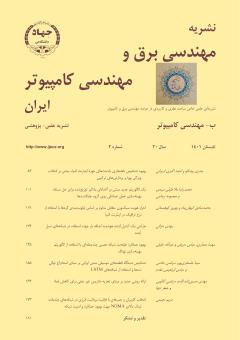انتخاب کاربران و جمرهای با قابلیت برداشت انرژی در شبکههای چندبانده لینک بالای NOMA جهت بهبود عملکرد و امنیت شبکه
محورهای موضوعی : مهندسی برق و کامپیوتر
1 - دانشگاه علم و فناوری مازندران ،دانشکده مهندسی برق و کامپیوتر
کلید واژه: , قابلیت گذردهی, احتمال قطعی محرمانه, احتمال قطعی ارتباط,
چکیده مقاله :
در این مقاله، ارسال امن لینک بالا در ارسال چندگانه غیر متعامد (NOMA) با انتخاب کاربرهای مناسب جهت ارسال به سمت ایستگاه پایه (BS) در هر کانال و جمرهایی با قابلیت برداشت انرژی بررسی میگردد. در واقع، هر فریم زمانی به دو فاز تقسیم میشود. در فاز اول، جمرها توان خود را از ایستگاه پایه برداشت میکنند و در فاز دوم، کاربران انتخابشده، ارسال لینک بالا را به صورت NOMA به ایستگاه پایه انجام میدهند، در حالی که جمر انتخابشده، نویز ساختگی خود را برای گمراهکردن کاربر استراق سمعکننده ارسال میکند. در واقع، مسئله مورد نظر، بهینهسازی قابلیت گذردهی محرمانه با انتخاب کاربرهای مناسب در هر کانال فرکانسی جهت ارسال داده به ایستگاه پایه و نیز انتخاب جمرهای مناسب است، البته با قیودی که روی احتمال قطعی محرمانه (SOP) و احتمال قطعی ارتباط (COP) در نظر گرفته میشود. مسئله مورد نظر با استفاده از روشهای مبتنی بر بهینهسازی محدب و شرایط KKT برای انتخاب کاربران مناسب، مطرح و الگوریتمی برای حل آن پیشنهاد میگردد و عملکرد سیستم برای روش پیشنهادی ارزیابی میشود. نتایج شبیهسازی بیانگر آن است که روش پیشنهادی، عملکرد بهتری از نظر بهبود قابلیت گذردهی و ایجاد امنیت در شبکه در شرایط و سناریوهای متفاوت نسبت به الگوریتمهای محک در نظر گرفته شده دارد.
In this paper, uplink secure transmission in a non-orthogonal multiple access (NOMA) network is investigated by selection of the users for data transmission to the base station (BS) and also jammers with the capability of energy harvesting. In fact, each frame has two phases. In the first phase, jammers harvest energy from BS and in the second phase, the selected users transmit their data to BS using NOMA technique while selected jammer emits the artificial noise for confusing the eavesdropper. In fact, the problem is maximizing the secrecy throughput by selection of the users for uplink data transmission to BS in each frequency channel and suitable jammers to make the artificial noise for eavesdropper with constraints on the secrecy outage probability (SOP) and connection outage probability (COP). The problem is solved based on the convex optimization methods and Karush-Kuhn-Tucker (KKT) conditions. An algorithm is proposed for solving the problem and the system performance is evaluated. Simulation results present that the proposed algorithm has the better performance for the throughput and security of the network in comparison with the benchmark algorithms in different situations and scenarios.
[1] L. Dai, et al., "Non-orthogonal multiple access for 5G: solutions, challenges, opportunities, and future research trends," IEEE Commun. Mag., vol. 53, no. 9, pp. 74-81, Sept. 2015.
[2] S. M. R. Islam, N. Avazov, O. A. Dobre, and K. S. Kwak, "Power domain non-orthogonal multiple access (NOMA) in 5G systems: potentials and challenges," IEEE Commun. Surveys Tuts., vol. 19, no. 2, pp. 721-742, 2nd Quart., 2017.
[3] Y. Liu, Z. Qin, M. Elkashlan, Y. Gao, and L. Hanzo, "Enhancing the physical layer security of non-orthogonal multiple access in large-scale networks," IEEE Trans. Wireless Commun., vol. 16, no. 3, pp. 1656-1672, Mar. 2017.
[4] C. Zhong and Z. Zhang, "Non-orthogonal multiple access with cooperative full-duplex relaying," IEEE Commun. Lett., vol. 20, no. 12, pp. 2478-2481, Dec. 2016.
[5] B. He, A. Liu, N. Yang, and V. K. N. Lau, "On the design of secure non-orthogonal multiple access systems," IEEE J. Sel. Areas Commun., vol. 35, no. 10, pp. 2196-2206, Oct. 2017.
[6] F. Zhou, Z. Chu, H. Sun, R. Q. Hu, and L. Hanzo, "Artificial noise aided secure cognitive beamforming for cooperative MISO-NOMA using SWIPT," IEEE J. Sel. Areas Commun., vol. 36, no. 4, pp. 930-931, Apr. 2018.
[7] Y. Feng, S. Yan, Z. Yang, N. Yang, and J. Yuan, "Beamforming design and power allocation for secure transmission with NOMA," IEEE Trans. Wireless Commun., vol. 18, no. 5, pp. 2639-2651, May 2019.
[8] F. Jameel, S. Wyne, G. Kaddoum, and T. Duong, "A comprehensive survey on cooperative relaying and jamming strategies for physical layer security," IEEE Commun. Surv. Tuts., vol. 21, no. 3, pp. 2734-2771, Jul. 2019.
[9] M. Liu and Y. Liu, "Power allocation for secure SWIPT systems with wireless-powered cooperative jamming," IEEE Commun. Lett., vol. 21, no. 6, pp. 1353-1356, Jun. 2017.
[10] Y. Bi and A. Jamalipour, "Accumulate then transmit: towards secure wireless powered communication networks," IEEE Trans. Vehicular Technology, vol. 67, no. 7, pp. 6301-6310, Jul. 2018.
[11] K. Cao, et al., "Improving physical layer security of uplink NOMA via energy harvesting jammer," IEEE Trans. on Information Forensics and Security, vol. 16, pp. 786-799, 2020.
[12] B. Rashid, A. Ahmad, S. Saleem, and A. Khan, "Joint energy efficient power and sub-channel allocation for uplink MC-NOMA networks," International J. of Communication Systems, vol. 33, no. 17, Article ID: e4606, 25 Nov. 2020.
[13] K. Cao, et al., "On the security enhancement of uplink NOMA systems with jammer selection," IEEE Trans. on Communications, vol. 68, no. 9, pp. 5747 - 5763, Sept. 2020.
[14] Y. Zou, "Physical-layer security for spectrum sharing systems," IEEE Trans. Wireless Commun., vol. 16, no. 2, pp. 1319-1329, Feb. 2017.
[15] K. Cao, B. Wang, H. Ding, T. Li, and F. Gong, "Optimal relay selection for secure NOMA systems under untrusted users," IEEE Trans. Veh. Technol., vol. 69, no. 2, pp. 1942-1955, Feb. 2020.
[16] W. Yu and R. Lui, "Dual methods for nonconvex spectrum optimization of multicarrier systems," IEEE Trans. on Commun, vol. 54, no. 7, pp. 1310-1322, Jul. 2006.
[17] D. P. Bertsekas, A. Nedic, and A. E. Ozdaglar, Convex Analysis and Optimization. Belmont, MA: Athena Scientific, 2003.

